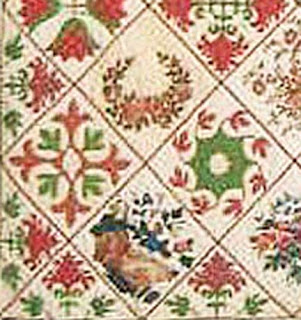Block (one-of-a-kind?) from a Quaker Album Sampler from
New Jersey. A rotating wheel-type applique cut from red, green & yellow calico.
In the last post I discussed the style characteristics of early Quaker album samplers (1842-1845)
I mentioned the odd blocks, pieced and appliqued.
Two odd blocks from Ella Maria Deacon's quilt at the Art Institute of Chicago.
The Burtis family quilt is typical in it's inclusion of cut-out chintz applique and conventional applique cut from calicoes. This quilt has only a few blocks with any piecing. I like that green star with the whirling leaves. The pattern never caught on.
Note the edge blocks here, a variation of this unnamed pattern that is repeated in early samplers
Tree with reverse applique, which was popular for a few years and disappeared.
I wrote a paper once for AQSG on those early album quilts and when and where they were made. One of my conclusions:
"Many designs popular in the [early] album quilts never became standard patterns. The broad range of appliqued patterns in the sampler albums of the mid-nineteenth century indicates that that the makers were exploring the design possibilities of a new technique...These signature quilts were design workbooks as well as expressions of friendship."
See "Signature Quilts: Nineteenth Century Trends" on page 29 of Laurel Horton's Quiltmaking in America: Beyond the Myths.
From a New Jersey sampler
that's set on the square. Quite quirky.
From the Conner Prairie Quaker sampler.
From the Gillingham quilt
Some of these unusual blocks may look familiar to those of
you who've made Di Ford's Antique Wedding Sampler,
inspired by Charlotte Gillingham's quilt in the black box;
a version of the reproduction behind it.
Di's Antique Wedding Sampler from her book Primarily Quilts.
Di picked the most graceful to reproduce.
Charlotte Gillingham's quilt dated 1842-1843
Collection of the Philadelphia Museum of Art
You get the feeling that the Quaker block makers were encouraged to draw their own designs. Not everyone's an artist. But you have to love the spontaneity in all the variations.
I've been looking closely at these early album/samplers because I'm sorting my photos of date-inscribed quilts. See Pinterest pages on quilts dated 1842 and 1843 here:











Yes! Thank goodness for some spontaneity!
ReplyDeleteLOVE the 1800s swatch book! I wish someone would do a line with bright bold colors and patterns like that!
ReplyDelete